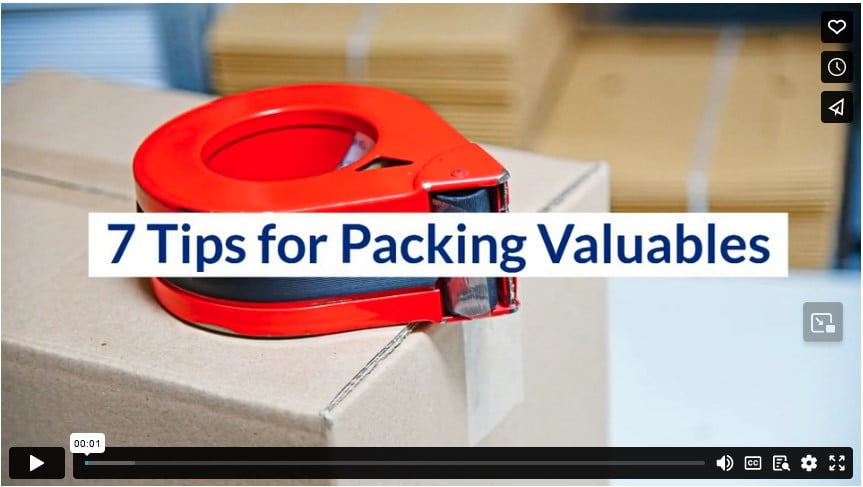Is there a person on this planet who enjoys packing? Probably not. But it’s a necessary part of your journey to your new beautiful home, so it has to be done. Even though packing is a dreaded part of moving, there are specific steps you can take to make sure your belongings arrive the same way they left and the process is as painless as possible.
Certain items can be thrown pell-mell into boxes. Easy peasy! Books are easy to pack. Hang clothes in wardrobe boxes for easy organization.
But what about that very delicate China set that’s been passed down for three generations? How do you pack that? What about the giant vase that was handmade for you?
If it’s not within your budget to pay someone to box your things for you, there are a few tips from professional packers you may want to follow to save yourself a few headaches, a lot of stress, and avoid potential damages.
1. Take Pictures of Your Valuables
Creating an inventory of your more valuable items is very smart. It creates a record of your expensive and priceless belongings in case anything is lost or damaged. It is way too time-consuming to do this with everything you’re moving, so stick with just your most precious possessions. Pictures make it much easier to show proof of the item’s original condition when you make a claim against your homeowner’s insurance or your moving company.
2. Opt for Insurance
Anything that goes on a truck should be insured. Your homeowner’s insurance may cover a move, and your moving company might offer extra insurance. Make sure you know their insurance policy and that your items are sufficiently covered.
3. Small and Important Stuff Goes with You
Moving companies don’t want to be liable for important documents, diamonds, or anything that would be devastating to lose. If it’s small and valuable, you may as well take it with you where you can keep close tabs on it.
4. Use Quality Boxes
You’re sure going to wish you spent $20 on quality boxes instead of raiding the Home Depot dumpster when your $1400 TV falls through and breaks. There are special padded boxes explicitly made for flat-screen TVs. Invest in the right kind of packaging for the items you value most.
5. Dishes go Upright with Lots of Padding
Dishes should be upright on their edge and stuffed with paper between each one. Stacking them flat-side down increases their chances of breaking if something hits the box. You can also use crumpled up newspaper, bubble wrap, packing paper or even towels for padding.
6. Be Thorough While Boxing
Make sure to pack your breakable items with enough cushion. After you pack your fragile items up, gently shake the box to ensure the contents don’t move. If they do, then you need to add more padding. Tape the boxes instead of just folding the box tops over to save tape. Make sure to fill the box adequately so the top of the box doesn’t cave in. There’s a science to it.
7. Fragile Markings
Put special markings on boxes that have extra fragile contents. You can write with a sharpie, create an ‘X” with tape, or whatever system works for you and your movers. Make sure everyone knows which boxes to handle with extra care.
How to Properly Pack TVs
First, remove all cables and accessories, and pack them in a separate box.
You can purchase a special box made to transport televisions. If you have the original box that it came in, along with the foam inserts, that works great too. Tape bubble wrap around the TV (Don’t get any tape on the actual TV), tape the box shut and you should be good to go. When securing a television with bubble wrap, use two people to make the process easier. You can also use two boxes as a stand to make it easier to pack the TV. Make sure to label “this side up” on the box.
Packing Computers
Your moving company can most likely pack your computer for you but if you choose to do it yourself and have the original packaging, place it in its original carton and packing materials. If you didn’t save the original box, then make sure to secure it in a sturdy container that is large enough for packing material to add a proper cushion. Newspaper or bubble wrap make great packing stuffers.
Remember that electronics might be exposed to the elements, which can be problematic. Electronics tend to be sensitive to heat and cold. Back up all your files just in case any warping or damage occurs. Remove the cartridge from any printers you may be moving and keep them in your vehicle.
More on Packing Dishes and Fine China
- Wrap china pieces separately before bundling them together. Start from the corner, wrap diagonally and tuck in overlapping edges. Use several sheets of paper.
- Wrap and stack plates in bundles of four and bowls in bundles of three
- Wrap all mugs and glasses individually
- Add extra wrapping to the stem of a wine glass before wrapping with packing paper
- Items that have lids and separate pieces should all be wrapped individually.
There’s no such thing as too much paper and tape so make sure you are well prepared. Your home should look like an Office Max before packing. Packing can be a grueling task, but if you do it right, you can protect your valuables from damage during your move.
Video
